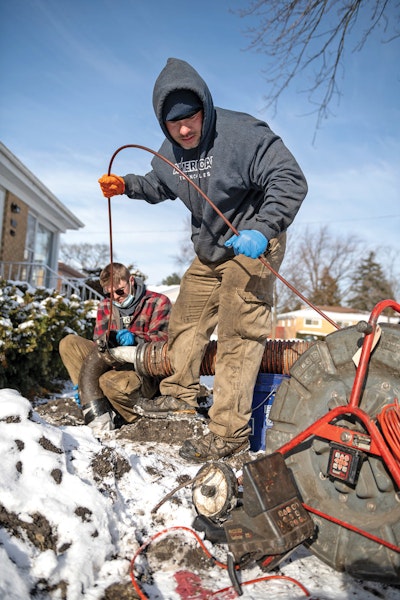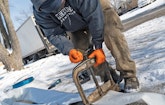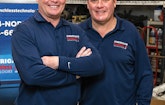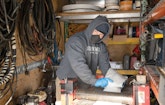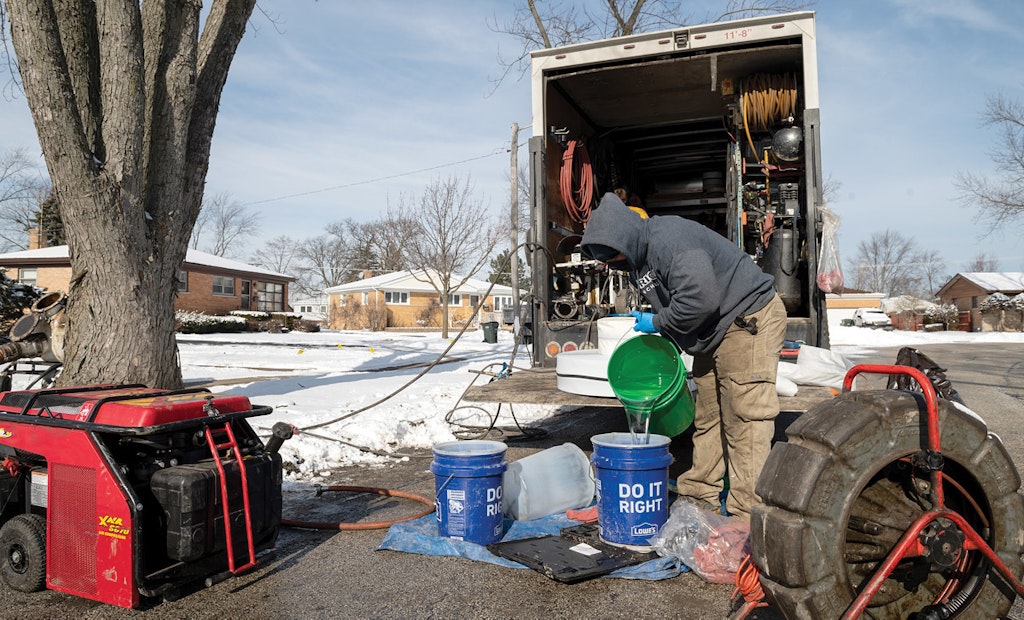O’Hare International Airport, a veterans hospital in Milwaukee and the Wisconsin state capitol don’t appear to have anything in common. But one thing connects them all: They’re among the more than 1,000 clients that have hired American Trenchless Technologies to fix serious pipeline problems with minimal disruption or downtime — and for significantly less money compared to conventional opencut repairs.
In just the three years since Mark Carpenter and his brother, Chris, founded the company in DeKalb, located about 65 miles west of downtown Chicago, they’ve amassed a considerable array of trenchless rehab equipment, including systems for lining, bursting and coating leaking drainlines.
The investments have been significant. Mark Carpenter estimates the company has bought about half a million dollars’ worth of equipment. But the return on those investments has been substantial. And with so many technologies available, the company is equipped to offer customers a variety of cost-effective solutions, he says.
“After all, the name of our company is American Trenchless Technologies. So we’d better offer more than one technology. It’s better when you can offer people different solutions.”
High returns
Some contractors shy away from big investments in new technology because of the high upfront cost. But it’s not unusual for Carpenter to buy new equipment for one job if it’s the best solution for the customer. The key: Charge a price that recoups most, if not all, of the initial cost.
“You can even let the customer know that you’re passing the cost onto them,” he says. “And in many cases, you can still do the job for half the price of conventional techniques, which are very disruptive. Most times the customer is willing to pay a higher price just so you can get in and get out quickly, with minimal disruption.”
Furthermore, that piece of equipment then allows the company to offer a new service and enter different markets, he adds.
A good example is the Quik-Coating System the company purchased in 2018 from Pipe Lining Supply. It was the best solution for repairing a system of leaking pipes in the 24-story Old Republic Building, a landmark classical revival-style building built in downtown Chicago in 1924.
Replacing the pipes would have required tearing down ornate plaster ceilings. In addition, it would’ve been difficult to get pipe lining equipment to the building’s roof, which was the logical access point for repairs. Lining the pipes would also require numerous line reinstatements for a large number of branch connections to the main drainlines, as well as negotiating numerous 90-degree bends.
The Quik-Coating system removes those factors from the equation. It uses a round, rotating brush to apply as many microthin layers of polyurea-based resin as the repair requires. The coating cures in five minutes.
“We bought the system just for that job,” Carpenter says. “It cost about $30,000. But it paid for itself on that job. And we still came in at a much lower price than other companies.”
Furthermore, the company now has another technological arrow in its quiver that’s available the next time a similar need arises.
Exploring options
In another instance, the company was called to fix about a 90-foot-long, 4-inch-diameter section of old Orangeburg pipe at a residence in DeKalb. The pipe ran under a large tree that the homeowners, a retired couple, had planted when they got married. Excavating to replace the pipe wasn’t an option.
“The building inspector wouldn’t let us do pipe lining because it was Orangeburg pipe,” Carpenter says. “So I called HammerHead Trenchless Equipment to talk about pipe bursting as an option.”
HammerHead provided training and also let the company rent a pipe bursting system. That allowed Carpenter to get a feel for the technology without making a significant upfront investment. He says many manufacturers are willing to do the same thing to improve product acceptance in the field.
“I was amazed at how well it worked out,” he says. “We got the job done and saved their tree and their landscaping.”
A new path
Carpenter started his career in the propane gas industry, installing storage tanks and gas lines with his father, Jack. In 2002, he bought an HVAC/plumbing franchise with his brother, which they ran for 15 years.
While attending a drain cleaning class, he heard about pipe lining technologies. “I didn’t even know this technology existed,” he recalls. “I remember thinking to myself, ‘Wow, what an interesting concept.’”
This discovery sent Carpenter down a different career path. When the franchise agreement expired, Carpenter realized he was more interested in lining pipes than plumbing services, so the brothers agreed to start a pipe lining company and plumbing/HVAC company, with his brother managing the latter’s operation.
“Nothing satisfied me like the lining business,” he says. “First of all, it’s a necessary service. When people have sewage coming into their home or business, they need it taken care of quickly.
“And when you show up and take care of their problems without any disruption — no tearing up their house, basement, patio, yard, driveway or whatever — you’re their hero. You become instant friends with people. It’s very satisfying.”
Early on, the company got business from plumbing and excavation companies that didn’t do pipe lining — and still does today. But Carpenter eventually steered toward a niche market: smaller jobs involving larger-diameter pipes, ranging from 8 to 18 inches in diameter.
“I found that bigger companies don’t want to do smaller jobs,” he says. “Bigger companies want municipal contracts for rehabbing miles of pipe, so we focus on smaller runs — jobs we can do in a day or two.
“It’s just a different ballgame than the larger companies play. Customers just couldn’t get larger companies to do shorter runs, which created opportunities for us.”
The company also found success by serving all kinds of customers, from municipalities, airports and military facilities to homes, hospitals and schools to industrial clients, he says.
Moreover, as the company earned a reputation for thinking outside the box, it started lining more than just typical drainlines. The company also has lined swimming pool drains, electrical conduit, air ducts, sump pits, basins, downspouts and even a spillway outlet for a dam.
“We’ve had some jobs where I look back and say, ‘How did we even do that?’ But if it’s lineable, we’re not afraid to try to line it.”
Technology-driven solutions
American Trenchless now owns a considerable roster of equipment. For pipe lining, the company relies on systems made by Alkota Cleaning Systems, CIPP Services, NuFlow, Perma-Liner Industries, Pipe Lining Supply and RapidAir Products.
The company also owns eight drain machines built by Spartan Tool and RIDGID; cart water jetters made by MyTana (3,000 psi at 8 gpm) and Spartan (3,000 psi at 12 gpm); a Badger TR 3100 mainline inspection camera manufactured by Aries Industries; five RIDGID SeeSnake and one SeeSnake Mini pipeline inspection cameras; and an IMS Micro Automatic Plus robotic cutter from Pipeline Renewal Technologies.
In addition, the company has invested in a Maxi Miller drain machine from Picote Solutions; a Clog Dog drain machine from the Clog Squad; and a Ditch Witch FX60 trailer vacuum system. The company also does pipe grouting; it uses grout and related products made by Avanti and a pump built by Graco.
Of course, it’s had to know what to buy without keeping up with the latest in technological developments, so Carpenter attends trade shows, reads trade magazines and attends training seminars sponsored by manufacturers.
“Plus I just talk to people,” he says. “You have to stay up on things because more and more people enter the market each year. I like to differentiate myself by staying a step ahead. I want to be one of the smarter, more well-informed people in the industry.
“Sometimes customers say to me, ‘No one else told me about that technology.’ That’s because they didn’t know about it. You’ve got to have a thirst for knowledge in this industry. And it moves fast, so it’s not easy to keep up with it all.”
A plan for growth
As Carpenter pauses to look at how American Trenchless has grown since its inception in 2017, he’s proud of what he and his brother have accomplished.
“Someone who mentored me once said I should find something I like to do and become the best at doing it. That always stuck with me and that’s what I’ve tried to do.”
Looking ahead, Carpenter says he’s developing a business plan aimed at tripling the company’s revenue in five years, to between $5 million and $6 million. That will require more technicians, salespeople and project coordinators, among other things.
Part of that growth could come from further expansion of existing services to new customers and possibly adding more services that complement existing ones, such as lining water-service lines as well as sewer lines, he explains.
But even as competition in trenchless pipe rehab grows, he’s not concerned, noting that there’s plenty of work available for everyone.
“The infrastructure is aging every year and it’s not going to fix itself. There’s quite a bit of opportunity out there.”
A creative approach
One thing Mark Carpenter loves about trenchless pipeline rehab is helping customers avoid the extreme disruption and high cost of traditional sewer line repairs. But another factor trips his trigger, too: He enjoys a good challenge.
That’s exactly what the co-owner of American Trenchless Technologies ran into several years ago when a customer in Geneva, Illinois, called with a big problem: a sewer line so badly broken that employees dubbed it “the impossible trenchless repair.”
The customer had torn down an old home and was building a larger new one. But before connecting the home to an existing sewer lateral, it had to be inspected, according to city regulations. The inspection revealed a severely deteriorated, roughly 50-foot-long section of 6-inch-diameter clay pipe. (A video of the inspection posted on YouTube has almost 475,000 views.)
“The line was almost fully clogged with mud and broken pieces of clay tile,” Carpenter says. “Parts of the top and side were busted out. We looked at the video and wondered how we would ever be able to line it, because using a water jetter to clear the line would collapse the whole thing.”
To make it worse, the sewer line ran under a two-lane state highway, with the mainline on the far side of the roadway. That meant Carpenter would need to get a permit from the Illinois Department of Transportation to dig up the highway — a process that can take months. Carpenter estimates that excavating to replace the section of pipe would cost $30,000 or more.
The dilemma spurred Carpenter into MacGyver mode. Instead of using a water jetter, he affixed a “fire nozzle” to a 1-inch-diameter PEX pipe and went to work. The nozzle created a spray pattern wide enough and just powerful enough to move debris forward, while the PEX was stiff enough to push the nozzle through, he says.
It took about two days of delicate maneuvering to clear the debris. Then he used a lining machine from Perma-Liner Industries to shoot a structural felt liner through the damaged section of pipe, under the highway and into the mainline.
The total lining time was a matter of minutes, not including ambient-curing time. The total cost rang in between $6,000 and $7,000. Customer satisfaction? Off the charts, he says.
“Things come up every day in this business and you’ve got to be able to figure them out. Sometimes you definitely need to be creative. Every job is a little different, just like snowflakes. But that’s what my guys and I like about it.”
